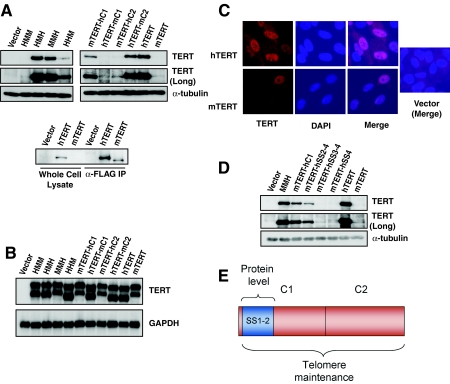FIG. 6.
hTERT accumulates to markedly higher protein levels than those of mTERT and these differences in protein level are controlled by SS1-2 sequences within the C1 domain. (A) Sequences regulating differences in mTERT and hTERT protein levels localize to the C1 domain. Western analysis detecting SPA-tagged TERT proteins HMM, HMH, MMH, HHM, mTERT-hC1, hTERT-mC1, mTERT-hC2, hTERT-mC2, hTERT, and mTERT (long, extended exposure time; α-tubulin, loading control) is shown. Differences in protein levels between mTERT and hTERT were also seen with FLAG-tagged TERTs (bottom panel). Protein analysis of FLAG-TERTs in total cell lysates (left) and α-FLAG immunoprecipitates (IP) (right) by FLAG Western blotting. (B) Differences in steady-state protein levels are not due to variation in RNA expression. Data shown are results of Northern blot analysis of SPA-TERT cells in panel A (TERT, SPA probe; GAPDH, loading control). (C) Nuclear localization of SPA-TERT in BJ cells. Indirect immunofluorescence analysis on vector-, SPA-hTERT-, and SPA-mTERT-transduced BJ cells (DAPI, nuclear counterstain; merge, DAPI and TERT signals combined). (D) Human SS1-2 sequences control steady-state protein levels. Western blot analysis of SPA-tagged chimeric proteins mTERT-hSS2-4, mTERT-hSS3-4 and mTERT-hSS4 (vector, MMH, mTERT-hC1, hTERT, and mTERT for comparison; long, extended exposure time; α-tubulin, loading control) is shown. (E) Model of TERT C-terminal domain. Sequences required for telomere maintenance are encoded in both C1 and C2 regions (red). Amino acids controlling protein accumulation are embedded within the C1 region (SS1-2, blue). These residues controlling protein level are separable from the larger domain regulating telomere maintenance.

